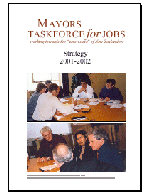

- NEW MINISTRY OF SOCIAL DEVELOPMENT
The Cabinet decided this week to merge the Department of Work and Income (Winz) and the Ministry of Social Policy into a new agency called the Ministry of Social Development. The two government organisations presently employ about 5,000 people. The position of the Chief executive of the new ministry will be advertised within the next fortnight.Social Services Minister Trevor Mallard says that the new ministry will be the government's primary adviser on "strategic and cross-sectoral social policy" as well as continuing to deliver income support and other social services to the community. Mallard: "The merger will not impact on other agencies in the short term. Even for MSP and DWI, it will be a relatively small change. We will not be re-advertising everyone's jobs and spending millions on re-branding. What we are chasing is quality advice and an approach to social delivery informed by social development."
- Despite the fact that the decision to merge the two agencies has already been made,
Trevor Mallard has also announced that he is developing terms of reference for a review of the public
service. He says this review will include such questions as:
— whether the large number of departments we have is appropriate
— whether some activities of crown entities should be performed departmentally
— the policy/operations division questions
— whether there are unnecessary compliance costs resulting from very legalistic contractual approach
— whether the current regime restricts appropriate devolution - National Party State Services spokesman, Roger Sowry, is concerned that the government
has made this restructuring decision without its usual sources of advice. He says that replies to
written Parliamentary questions have revealed that the government sought no advice from the Ministry of
Social Policy, Work and Income New Zealand, Department of Prime Minister and Cabinet or the State
Services Commission. Sowry: "The decision was made at Cabinet on Monday on the basis of an oral
item. This is an appalling process."
Sue Bradford of the Green Party agrees. She says it makes no sense for the Government to decide on and announce a radical restructuring to create a new ministry and in the same announcement to say that terms of reference are starting to be developed to review the public service. Bradford: "It seems as though the Government have put the cart before the horse in a major way. They have announced their plans and are now doing the review after the event ..."
-
 Roger Sowry is also arguing that the restructuring measures have been ordered in order to
avoid potentially expensive employment court action from Winz boss Christine Rankin, whose contract is
up for renewal in July.
Roger Sowry is also arguing that the restructuring measures have been ordered in order to
avoid potentially expensive employment court action from Winz boss Christine Rankin, whose contract is
up for renewal in July.
Sowry: "This merger is not about better social policy it is all about avoiding expensive employment proceedings against an individual. It is an expensive way to try and avoid Employment Court action — we know Social Services and Employment Minister Steve Maharey is in trouble with his comments over Work and Income chief executive Christine Rankin which may well lead to a substantial payout ... It is wrong to build a policy around one person rather than tailor it to the thousands of people it will affect."
Sources — Press Release NZ Government 11 April 2001 "Cabinet decision on Ministry of Social Development" and ""Maharey: Proposal to Refocus Key Social Service Departments And Ministries Timely"; Press Release National Party Roger Sowry 11 April 2001 "Govt Dodges Rankin in Social Services Merger"; Press Release Green Party Sue Bradford 11 April 2001 "Process All Wrong for New Super Ministry"; Press Release ACT Party Muriel Newman "Government Spin Reaches New Heights"
- VOICES:ON THE NEW MINISTRY OF SOCIAL DEVELOPMENT
"We do not wish to undertake wholesale reform or restructuring of the public service. But we are looking for a plan for significant improvement which could be developed and put in place for implementation over a period of years..."
— Trevor Mallard, State Services Minister" This decision is part of a wider review of the effectiveness and efficiency of structures within the public service. It is about getting better alignment between the policy and operational arms, it is about a focus on outcomes, and it is about a strategic and whole of government approach.
" I am committed to a much enhanced strategic social policy function with a whole of government role. There are a number of structural and organisational possibilities that need to be considered on how the vital strategic social policy function sits within the new arrangements.
" Both the Department of Work and Income and the Ministry of Social Policy have come along way over the past 12 months. This announcement should be seen as an opportunity to build on those gains..."
— Steve Maharey, Social Services and Employment Minister"Trevor Mallard says that the new Ministry will be able to develop cross sectoral policy advice, but that is nonsense. If that is the case why has this Government shifted the Community Employment Group from Winz to the Department of Labour, and moved Housing policy out of the Ministry of Social Policy into the Ministry of Housing?"
— Roger Sowry, National Party State Services spokesman" The Greens are really concerned about yet another major restructuring of the provider of welfare services to New Zealanders. For a department that has been turned upside down a number of times over the last 16 years, this will result in a great deal more uncertainty for both employees and beneficiaries ..."
— Sue Bradford, Green Party Social Services Spokesperson" This merger is nothing more than a snow-job to disguise future personal grievance claims caused by the injudicious comments of the minister himself. A potentially huge claim has been signalled for a long time. To get themselves out of a humiliating situation, the Government has unilaterally decided on a merger as a `quick-fix'. They are bypassing consultation, costings, and all the normal processes which mark public sector restructuring.
" Five thousand Winz staff, and all of the Ministry employees, must be reeling from this decision. The Government has acted deceitfully and with complete disregard for procedure or commonsense. We have seen situations where the Government has spent millions on consultations - the F16 purchases, the dairy company merger, MyBank — only to then ignore that advice. Now they have reached a stage where they skip consultation altogether."
— Muriel Newman, ACT Social Welfare Spokesman - MAYORS MEET IN MANUKAU CITY
The Mayors Taskforce for Jobs has had its three-day meeting in Manukau City, and has finalised a strategic plan for the next year. The strategy meeting was attended by a core group of nine Mayors, and the final "networking" day included 40 invited participants from councils, community organisations and government departments.The Strategic Plan outlines how the Mayors will support each other to:
— take leadership locally on employment issues
— provide advocacy on nation-wide employment policies and programmes in the light of local experience
— build stronger relationships between local and central government agencies, and
— promote leadership on employment goals as an issue for the upcoming local government elections.Copies of the "Strategy 2001-2002" document are available on the Mayors Taskforce website at www.jobsletter.org.nz/mtfjobs.htm
- One of the main reasons for the Manukau meeting was for Taskforce members to meet up
with Auckland Mayors, and to directly encourage them to join the Taskforce efforts. Bob
Harvey (Waitakere) and Sir Barry Curtis (Manukau) both indicated they will support the initiative. However,
a special meeting with Auckland City Mayor, Christine Fletcher, was cancelled.
— The Mayors who attended the Manukau meeting included Garry Moore (Christchurch), Jenny Brash (Porirua), Derek Fox (Wairoa), Yvonne Sharp (Far North), Pat O'Dea (Buller), Tim Shadbolt (Invercargill), Mary Ogg (Gore), Maureen Reynolds (Tararua), and Chas Poynter (Wanganui).
- TE ARAROA
 Many of the Taskforce Mayors have been advocating for public works programmes in their
areas which will offer employment and training opportunities for local unemployed. The Mayors are keen
to support Te Araroa — The Long
Pathway project (completing a walkway from Cape Reinga
to Stewart Island) as both a national employment initiative, and as a stimulant for tourism development
in the regions that are on the Long Pathway.
Many of the Taskforce Mayors have been advocating for public works programmes in their
areas which will offer employment and training opportunities for local unemployed. The Mayors are keen
to support Te Araroa — The Long
Pathway project (completing a walkway from Cape Reinga
to Stewart Island) as both a national employment initiative, and as a stimulant for tourism development
in the regions that are on the Long Pathway.
Geoff Chapple, Executive Officer of the Te Araroa Trust, was a speaker at the Mayors meeting in Manukau City. He points out that Te Araroa will not be a wilderness trail. At the end of most nights, walkers will be able to rest up in local communities, visit craft shops and historical sites, eat at restaurants and stay at motels/hotels and bed-and-breakfasts. This obviously stimulates local economies.
Last year, on a Churchill Fellowhip, Chapple undertook long trails operating in the USA, Canada and the UK. In Britain, the Countryside Agency has surveyed the economic spin-offs from visiting walkers to the "Offa's Dyke" Path in Wales. The agency calculated that, in the 1994-5 year, walkers on the path spent £2 million in the local economy. This was more than £20 for every £1 spent on the management of the trail.
Using research previously carried out on the "Pennine Way" in North England, which calculated that one job was created for every £14,000 of visitor spend, the survey concluded that the Offa's Dyke path sustains 153 jobs within the path corridor area.
Chapple: "Council support for these walkway projects is critical to opening up its local economic potential. Overseas research is showing us that we don't as easily get the corporate support for the long trails until we get the council backing. In terms of stimulating your local economies, the council contribution to the walkways has a definite multiplier effect..."
- Chapple says that Te Araroa is not just aimed at backpackers and overseas tourists. His hope
is that it will become a New Zealand tradition that you should "... do it before you die."

He says that most walkers will probably not choose to undertake the walk all at once. The Appalachian Trail in America is mostly done by "section walkers" who will spend about three days on the trail at a time, and complete it over several years. Building a local tradition of "section walking" here in New Zealand is one of the main objectives of the Te Araroa Trust.— Geoff Chapple is also a prominent NZ journalist and author, and a commentary on his own walk down the North Island Te Araroa Pathway can be read at www.teararoa.org.nz
Sources — Geoff Chapple speech to the Mayors Taskforce for Jobs Manukau City 29 March 2001; "Offa's Dyke Path National trail User Survey 1994-95" (The Countryside Commission); "Long Trails — origins, governance, and volunteer support in the USA, Canada and UK" by Geoff Chapple (based on a Churchill Fellowship of 2000)
- WARNING OF MORE TEACHER SHORTAGES
A Staffing Report by the Ministry of Education recommends that an extra 3,500 full-time teachers be found to work in primary and secondary schools. The report says that NZ schools cannot deliver adequate education because of the shortage of teachers and it recommends an increase from the present 35,000 fulltime teaching positions to 38,500 positions, a rise of just over 10%.It would cost $220 million for the government to implement all of the report's recommendations, which include increasing staff numbers in smaller primary schools and a reduction of staff-student rations in Maori immersion schools and bilingual classes.
Education Minister Trevor Mallard acknowledges that "teachers have made it pretty clear to me that workload is a big issue for them ...", but he says that the speed at which any recommendations in the Staffing report are implemented would depend on the latest round of Post Primary Teacher Association (PPTA) pay negotiations.
- Where would all the new teachers come from? No one seems sure. Schools have started
this year with nearly 400 teachers short, according to the Ministry of Education. A booming
secondary school population, an ageing workforce of teachers, a sharp drop in teacher trainees, and a
worldwide shortage of teachers ... all mean that very serious shortages will be likely in the next five years.
— An Education Ministry survey has found that at the first day of term, 345 schools had vacancies, compared with 295 schools last year. In secondary schools, mathematics and science positions account for 14% of the teacher vacancies, and technology positions make up 12 %. Rural areas, and schools with more Maori students and a lower socio-economic decile rating, have higher vacancies.
— secondary school rolls are expected to peak in 2007.
— the average age of the secondary teacher workforce is 43 years.
— The Wellington College of Education reports that 141 people applied for secondary teacher training this year, compared with 259 five years ago. Similarly, the Auckland College of Education had experienced a fall in trainees from 555 in 1998, to 327 this year.Sources — New Zealand Herald 14 March 2001 "3500 more techers needed" by Libby Middlebrook and Audrey Young; New Zealand Herald 28 March 2001 "School year began with 400 teachers short" by Rebecca Walsh

Top of Page
This Letter's Main Page
Stats | Subscribe | Index |
The Jobs Letter Home Page | The Website Home Page
jrt@jobsletter.org.nz
The Jobs Research Trust -- a not-for-profit Charitable Trust
constituted in 1994
We publish The Jobs Letter

Essential Information on an Essential Issue

Letter No.142
12 April, 2001

The MAYORS TASKFORCE for JOBS has met in Manukau City to finalise its Strategic Plan for the next year.
Photos from the Manukau Meeting
What are the Mayors Up To?











